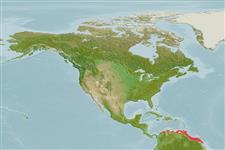>
Eupercaria/misc (Various families in series Eupercaria) >
Haemulidae (Grunts) > Haemulinae
Etymology: Haemulon: Greek, haimaleos = bloody (Ref. 45335).
Environment: milieu / climate zone / depth range / distribution range
Ecología
marino asociado a arrecife; rango de profundidad 0 - 100 m (Ref. 3798). Tropical; 22°N - 4°N, 98°W - 50°W
Distribución
Países | Áreas FAO | Ecosistemas | Ocurrencias, apariciones | Point map | Introducciones | Faunafri
Western Atlantic: Colombia to French Guiana.
Tamaño / Peso / Age
Maturity: Lm ? range ? - ? cm
Max length : 19.0 cm TL macho / no sexado; (Ref. 9626); common length : 15.0 cm TL macho / no sexado; (Ref. 3798)
Espinas dorsales (total): 13 - 14; Radios blandos dorsales (total): 13; Espinas anales 3; Radios blandos anales: 8 - 9. Head scaled except for tip of snout and chin; mouth small and oblique; yellowish to greenish silver on back, silvery on sides, with 4 brown to bronze stripes on upper half of body and a large black spot at caudal base (Ref. 13442).
Generally in protected areas such as bays or inlets; rarely in insular areas with clear oceanic water and coral reefs (Ref. 5217). Juveniles encountered near the shore. Feeds on small crustaceans and mollusks (Ref. 3798). Taken incidentally and not considered commercially important (Ref. 3798).
Life cycle and mating behavior
Madurez | Reproducción | Puesta | Huevos | Fecundidad | Larva
Distinct pairing during breeding (Ref. 205).
Cervigón, F., 1993. Los peces marinos de Venezuela. Volume 2. Fundación Científica Los Roques, Caracas,Venezuela. 497 p. (Ref. 9626)
IUCN Red List Status (Ref. 130435)
Threat to humans
Harmless
Human uses
Carnada: occasionally
Más información
ReferenciasAcuiculturaPerfil de acuiculturaRazasGenéticaElectrophoresesheritabilidadEnfermedadesProcesamientoNutrientsMass conversion
ColaboradoresImágenesStamps, Coins Misc.SonidosCiguateraVelocidadTipo de nataciónSuperficie branquialOtolitosCerebrosVisión
Herramientas
Special reports
Download XML
Fuentes de Internet
Estimates based on models
Preferred temperature (Ref.
123201): 25.4 - 28.2, mean 27.2 °C (based on 138 cells).
Phylogenetic diversity index (Ref.
82804): PD
50 = 0.5000 [Uniqueness, from 0.5 = low to 2.0 = high].
Bayesian length-weight: a=0.01479 (0.00702 - 0.03115), b=2.99 (2.82 - 3.16), in cm total length, based on LWR estimates for this Genus-body shape (Ref.
93245).
Nivel trófico (Ref.
69278): 3.5 ±0.50 se; based on food items.
Resiliencia (Ref.
120179): Alto, población duplicada en un tiempo mínimo inferior a 15 meses (Preliminary K or Fecundity.).
Fishing Vulnerability (Ref.
59153): Low vulnerability (10 of 100).
Nutrients (Ref.
124155): Calcium = 65.2 [21.1, 122.1] mg/100g; Iron = 0.686 [0.359, 1.217] mg/100g; Protein = 19.1 [17.3, 20.9] %; Omega3 = 0.167 [0.087, 0.269] g/100g; Selenium = 31.9 [19.1, 54.3] μg/100g; VitaminA = 107 [43, 261] μg/100g; Zinc = 1.39 [0.95, 2.08] mg/100g (wet weight);
